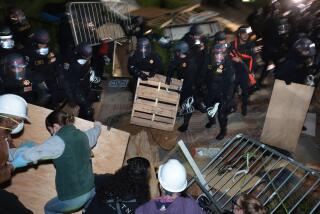Residents Want to Turn Off Yellow Lights : Long Beach: The low-pressure sodium lights used on streets are high on energy efficiency but low on aesthetic appeal.
It has been more than a decade since this city’s first energy-saving street lights were installed, and a lot of people grumble that Long Beach has been in the “twilight zone” ever since.
Little loved from the beginning, the low-pressure sodium or so-called yellow lights have failed to win many local fans since the city started installing them in 1978.
Downtown residents and businessmen are working to create a special assessment district to pay for replacing the lights along at least some of the downtown streets, and the City Council appears increasingly receptive to suggestions that the system should eventually be ditched citywide.
“It’s depressing light. It was a mistake and it has to be corrected,” declared Mayor Ernie Kell, who voted for the yellow lights when they were first proposed and now regrets it.
The lights may be high on energy efficiency, but they are low on aesthetic appeal. They wrap sidewalks in an eerie yellowish glow that can leave pedestrians with the impression that they forgot to take their sunglasses off when the sun went down. “It makes everything a shade of a shadow,” complained Bill Stovall, a former deputy police chief who is running for downtown’s 1st District council seat.
The low-pressure sodium light covers only a very narrow end of the light spectrum, and thus turns objects gray and muddy, regardless of their color.
Critics gripe that the yellow lights make the streets look dingy, dim and dangerous. They point to the high-pressure sodium, or white, lights that are being installed along the route of the rail transit system on Long Beach Boulevard as an example of what real lights look like.
“God, it’s like the difference between night and day,” exclaimed Bob Treese, a downtown resident and member of a downtown anti-crime committee. “You can see,” Treese said of the new lights along the rail route. “You can see color, you can see shadow. You can see potential problems. And you cannot do that under the old lights.”
Technical experts say the charge of dimness is grounded more in perception than reality. “I think it’s just the way they look,” City Engineer Ed Putz said. “I think if you stand there with a light meter . . . the light output would be the same. But there’s something subjective. People think it’s dimmer.”
“In point of fact, they are as bright,” confirmed Steve Goldmacher, spokesman for Philips Lighting Co., which manufactures both low-pressure and high-pressure sodium lights.
Kell considers the lights along the rail route--installed by the Los Angeles County Transportation Commission--something of a test of public sentiment. “I think this is going to be kind of a trial to see if people really like the difference and are willing to pay for it.”
Pay they will have to if the low-pressure sodium system is relegated to the scrap heap. The city’s energy bill would “go up probably on the order of $500,000 a year, could be $1 million” if high-pressure sodium lights were installed citywide, Putz said.
Moreover, the costs of conversion have been projected as high as $70 million for a citywide switch to high pressure, since the change would require an upgrading of the street light circuitry.
While some yellow-light critics insist the conversion could be accomplished for substantially less, most agree that the city’s general fund could never absorb the expense of installing a new lighting system across Long Beach. One alternative is the creation of assessment districts such as the one being proposed for downtown, in which residents and businesses in a certain neighborhood band together to pay an annual fee both for the conversion and to cover the increased energy costs.
“Clearly, I think the council is prepared if the people are prepared to vote the money for it,” observed Councilman Evan Anderson Braude, who said he has long advocated replacing the yellow lights downtown with a more appealing luminescence.
Kell said: “I think the citizens would vote to support this with a slight tax. People dislike the yellow lights that much.”
There are no estimates of what a citywide assessment district would cost residents. But members of a downtown assessment district would probably pay about $3 per frontage foot per year, or an average of $100 to $200 a year for a typical business.
Proponents of a new lighting system argue that saving energy is not the paramount concern it was in the late 1970s, when oil costs were spiraling, and that safety is of greater import. “Maybe we’re saving some fossil fuel, but how many people have died because of the crime?” Treese remarked.
They also say that high-pressure sodium lights are more efficient than they used to be. Nonetheless, Goldmacher, the Philips Lighting spokesman, said the low-pressure sodium lights are still about 30% more energy efficient than high-pressure ones.
San Diego, the only other major city in California to use low-pressure sodium lights, recently decided to stick with them, despite efforts to keep the yellow lights out of San Diego’s downtown Gaslamp Quarter.
San Diego began installing low-pressure sodium lights throughout the city several years ago to limit light pollution that would interfere with astronomical observations at the Palomar Observatory and Mt. Laguna.
The same complaints that have dogged the Long Beach lights have surfaced in San Diego. But countering them were the observatory concerns, money savings of at least $500,000 a year, and testimony from the Police Department that the yellow lights had no discernable effect on fighting crime.
“So far, so good,” San Diego Police Department spokesman Bill Robinson said of the low-pressure lights. Although the department was at first concerned that police would have difficulty identifying suspects because of the lights’ yellow cast, Robinson said that has not been the case.
Long Beach police spokesman Lt. Melvin Gallways said police do not like the yellow lights because of the color distortion. He also said he believed crime had slightly decreased along the rail transit line since the white lights were installed. However, he was not aware of any studies or statistics showing the yellow lights to be less effective crime deterrents than the white lights.
More to Read
Start your day right
Sign up for Essential California for news, features and recommendations from the L.A. Times and beyond in your inbox six days a week.
You may occasionally receive promotional content from the Los Angeles Times.







